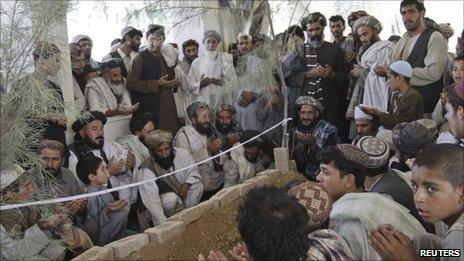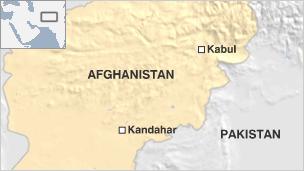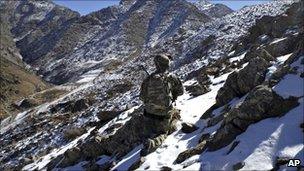Kandahar: Afghanistan's turbulent province
- Published

Pashtuns comprise the major ethnic group in Kandahar and Pashtu is spoken by the overwhelming majority of people
It has often been said that whoever controls Kandahar controls Afghanistan.
Kandahar is the heartland of the country's largest ethnic group, the Pashtuns. It is also the spiritual home of the Taliban - and the birthplace of President Hamid Karzai.
Kandahar is considered strategically important because of its international airport, its agricultural and industrial output and its position as one of the country's main trading hubs.
Kandahar city was founded by Alexander the Great in the 4th Century, although the region around it contains the remains of human settlements believed to be about 7,000 years old.
The area's strategic importance and significance as a trade route mean it has been fought over for many centuries.
During the past five years, the province has seen heavy fighting between Nato and the Taliban - most of the extra 30,000 troops deployed by US President Barack Obama in his surge of 2009 have been stationed there.
Major tribes
A land of plains and mountains, the province has always been considered a major prize.
The UN says Pashtuns comprise the major ethnic group in Kandahar and Pashto is spoken by about 98% of its population. Dari and Balochi are also commonly spoken in the province of about 990,000 people.
Kandahar's major tribes are the Popalzai (of which President Karzai and his family are members), the Barakzai, the Alkozai, the Noorzai and the Alezai.
The tribal structure is complex and deeply rooted - such allegiances are often important considerations when political appointments are made, observers say.
Members of the predominantly Pashtun Taliban in Kandahar are thought to be recruited from a variety of tribal groups.

Kandahar city was conquered by Arabs in the 7th Century and since then has been occupied by Mongol, Mughal and Persian invaders.
The rulers of emerging Afghanistan made it the capital of their newly independent kingdom in the middle of the 18th Century.
British forces occupied Kandahar during the first Afghan war from 1839-42 and from 1879-81. During the Soviet military occupation of 1979-89, Kandahar was the site of a Soviet command.
Ideologically significant
A variety of UN and government agencies are currently involved in reconstruction and development projects in different parts of the province, where many areas lack basic infrastructure such as water and sanitation, energy and transport.
The overall literacy rate in Kandahar is just 16%.

Kandahar's terrain - like its culture and history - is wide and varied
However the UN says the transport infrastructure of Kandahar is relatively well developed for Afghanistan, with more than 76% of its roads able to take vehicles in all seasons.
Experts say the province is not only ideologically significant for the insurgency, but also their battleground of choice, offering rocky outcrops, desert routes and fields and orchards that offer good cover.
Tactics most commonly used by the insurgents in recent years include suicide attacks, roadside bombings, land mines and ambushes.
Although Nato says its surge has improved security in the province, an indication of the Taliban's strength was clearly seen in April 2011, when inmates managed to escape from one of Afghanistan's biggest prisons.
At least 470 prisoners, including Taliban commanders and fighters, fled overnight through a tunnel from Sarposa jail just outside Kandahar city. It was the second big jail break there within three years.
Up until his assassination in July 2011, the person with the most power in Kandahar was Ahmad Wali Karzai, the high-profile half-brother of President Karzai.
The BBC's Lyse Doucet says the president relied on his younger half-brother to consolidate his tribal and political sway in the south.
Ahmad Wali was his not-so-secret weapon in winning elections and protecting the Karzai family interests.
His death has left a dangerous political vacuum in the province and uncertainty as to who will be his successor at a time when Kandaharis still live in constant fear of attack from either the Taliban or US-led forces.
- Published12 July 2011
- Published29 May 2011